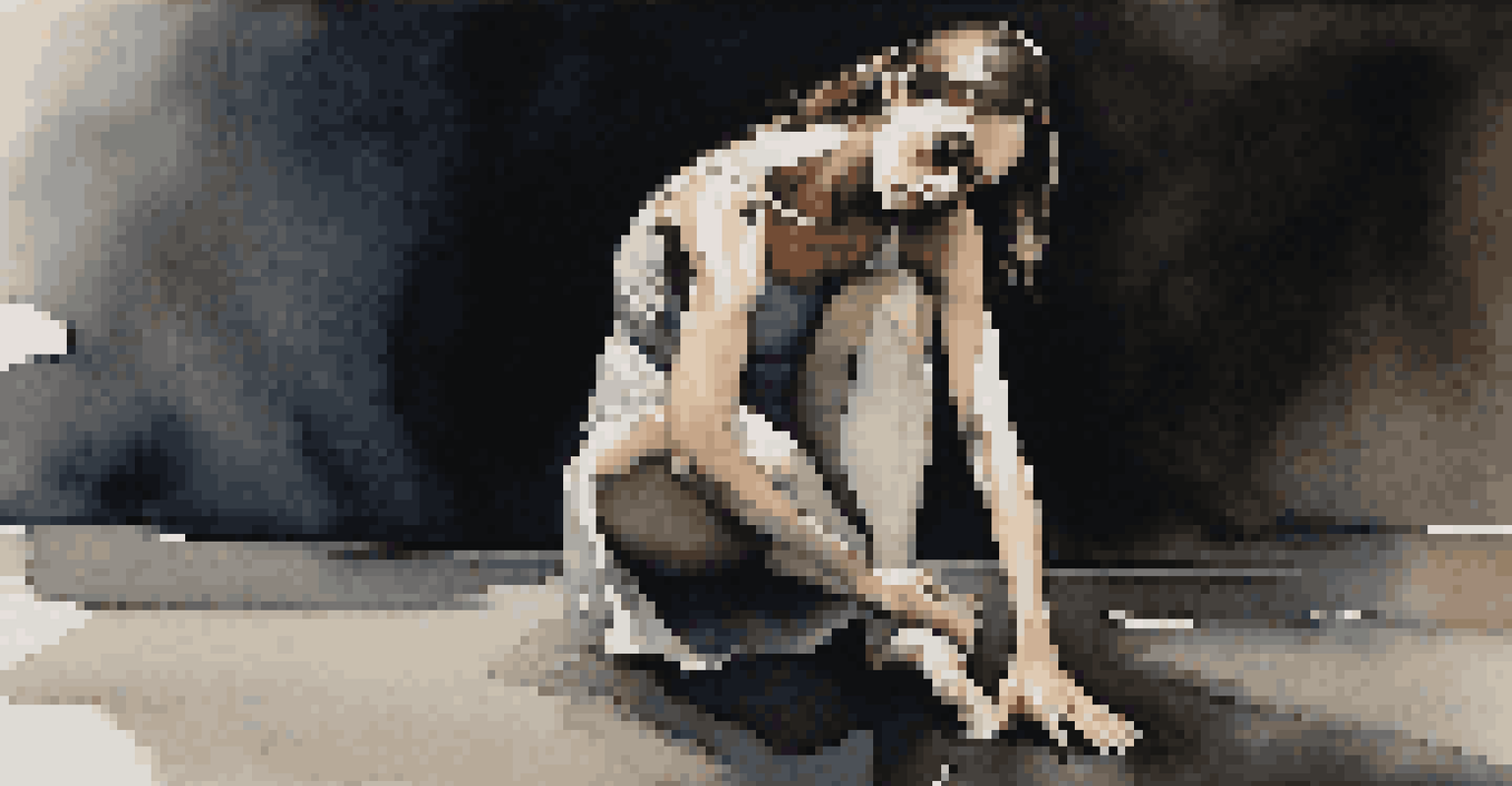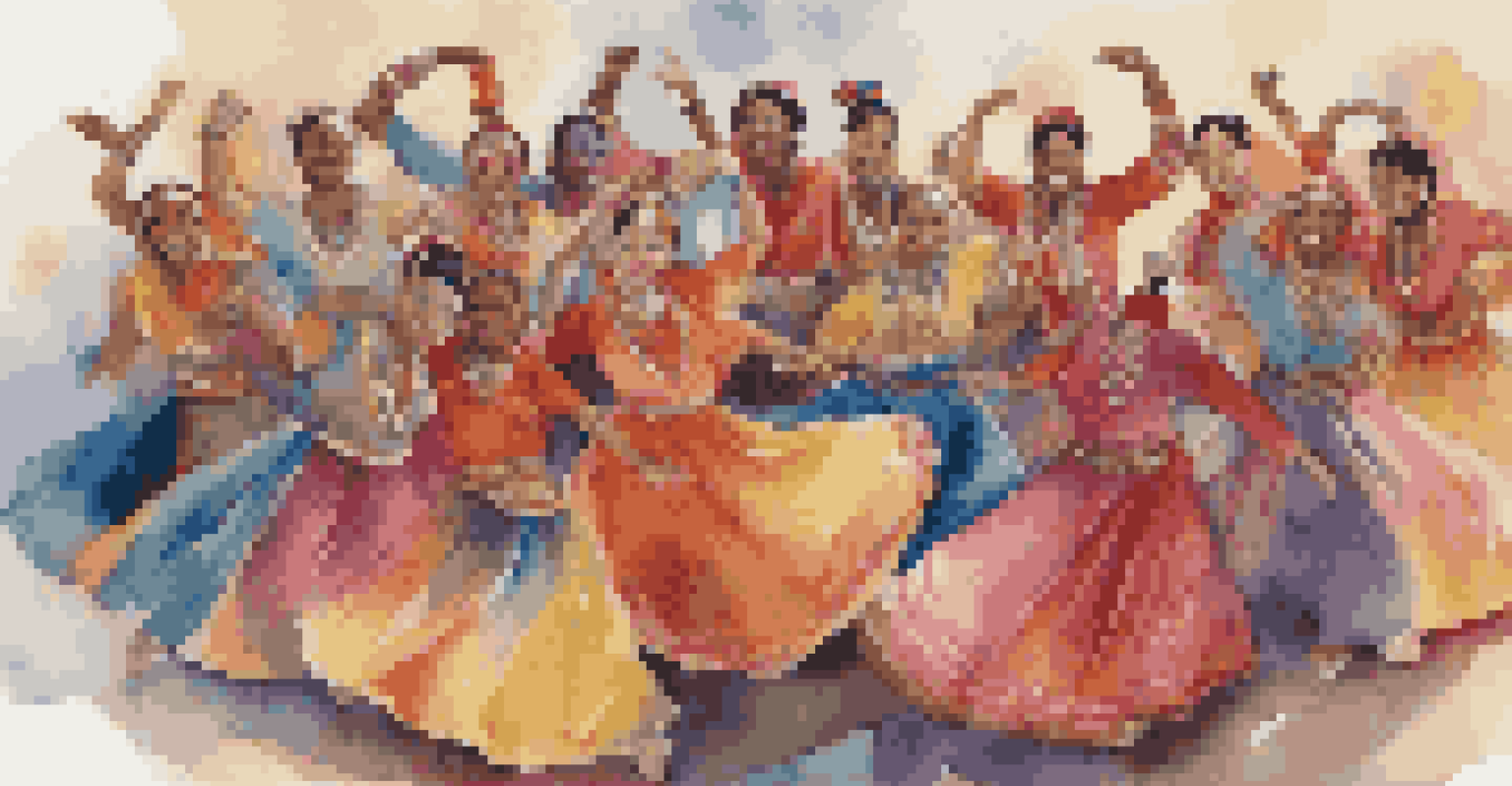The Significance of Facial Expressions in Dance Communication

What Are Facial Expressions in Dance?
Facial expressions in dance are the subtle yet powerful cues that dancers use to convey emotion and narrative. Just as a painter uses colors to express feelings, dancers utilize their faces to communicate with their audience. These expressions can range from joy and anger to sadness and surprise, adding depth to the performance.
Dance is the hidden language of the soul.
When dancers incorporate facial expressions, they help to narrate the story behind the movements. For instance, a dancer executing a graceful leap might enhance the beauty of the moment by smiling, inviting the audience to share in their joy. This connection between movement and expression is vital for creating a compelling performance.
Moreover, facial expressions can serve as an emotional guide for the audience. They can elevate the impact of the dance, making the experience not just visual but deeply emotional. Without these expressions, the dance might feel flat or disconnected, lacking the richness that comes from genuine emotional communication.
The Role of Emotions in Dance
Emotions are at the heart of dance, and facial expressions are a key component in expressing these feelings. Dancers often draw from personal experiences to evoke real emotions, which they then translate into their performances. This authenticity resonates with audiences, creating a shared experience.

For example, a dancer portraying grief might use their eyes to convey sadness, while their body movements might reflect a struggle. This duality creates a powerful narrative, allowing the audience to engage on multiple levels. The synergy between body language and facial expression deepens the emotional impact.
Facial Expressions Convey Emotion
Dancers use facial expressions to communicate emotions and narratives, enriching their performances and connecting with the audience.
Additionally, the emotional landscape of a dance can shift throughout the performance. A dancer might start with a somber expression that gradually transitions into one of hope or joy. This evolution mirrors the complexities of human emotions, making the performance relatable and compelling for the audience.
Cultural Variations in Facial Expressions
Facial expressions in dance can vary significantly across different cultures, reflecting diverse emotional languages. In some cultures, expressive faces are celebrated and encouraged, while in others, subtlety may be preferred. Understanding these nuances adds richness to the dance form and its interpretation.
The body says what words cannot.
For instance, traditional Japanese dance often emphasizes restraint and minimal facial expression, conveying emotions through precise movements. On the other hand, Latin dances tend to embrace bold and expressive facial cues, enhancing the passionate nature of the performance. Each style tells its own story through these cultural lenses.
When dancers cross cultural boundaries, they must be mindful of these differences in expression. This awareness helps them connect more authentically with diverse audiences. By blending elements from various cultures, dancers can create unique performances that resonate on multiple levels.
Facial Expressions and Audience Engagement
Facial expressions play a crucial role in engaging the audience during a dance performance. When dancers make eye contact and use expressive faces, they invite spectators into the story, enhancing their overall experience. This connection transforms passive viewers into active participants.
For example, a dancer who smiles at the audience during a joyful routine creates a sense of inclusivity, making spectators feel as though they are part of the celebration. Conversely, a somber expression during a serious piece can evoke empathy, drawing the audience deeper into the emotional core of the performance.
Cultural Influences on Expressions
Different cultures have unique approaches to facial expressions in dance, affecting how emotions are conveyed and interpreted.
Ultimately, the effectiveness of a dance is amplified by the dancers' ability to communicate through their faces. A performance that resonates emotionally often leaves a lasting impression, encouraging audiences to reflect on their own experiences and feelings long after the final bow.
Training Facial Expressions for Dancers
Training to use facial expressions effectively is an essential part of a dancer's education. Many dance schools incorporate specific exercises aimed at enhancing emotional delivery through the face. These might include improvisational activities, mirror work, and character development techniques.
Dancers learn to control their facial muscles and express a wide range of emotions convincingly. For instance, a dancer may practice portraying joy by experimenting with different smiles or practicing how to convey sadness through subtle frowns and wide eyes. This level of training helps them become versatile performers.
Moreover, feedback from instructors and peers plays a critical role in this training. Constructive criticism can help dancers refine their expressions, ensuring they align with the movements and overall narrative. This continuous improvement process is vital for developing a dancer's unique emotional voice.
The Impact of Social Media on Dance Expressions
In today's digital age, social media platforms have transformed how dancers share their art, including their facial expressions. Short videos and live streams allow dancers to showcase their performances to a global audience, emphasizing the importance of facial expressions in making a memorable impact. This exposure can lead to new trends in dance communication.
For instance, viral dance challenges often highlight specific facial expressions that resonate with viewers, making the dance more relatable and shareable. Dancers must adapt their expressions to capture attention quickly, often leading to a more exaggerated or stylized form of communication.
Training Enhances Expressive Skills
Effective training in facial expressions is crucial for dancers, helping them master emotional delivery and elevate their performances.
However, this shift also raises questions about authenticity. As dancers strive to create content that goes viral, they may feel pressure to conform to popular expression styles. Balancing genuine emotional communication with the demands of social media can be a challenging but essential aspect of modern dance.
Conclusion: The Power of Expression in Dance
Facial expressions are much more than just an accessory to dance; they are a fundamental part of how stories and emotions are conveyed. Through a combination of training, cultural influences, and personal experiences, dancers can master the art of facial communication. This skill elevates their performances, making them more engaging and relatable.
As audiences, we are drawn to the emotional depth that these expressions provide. They form a bridge between the dancer and the viewer, fostering a connection that can be both exhilarating and cathartic. In this way, facial expressions enrich the dance experience, transforming it into a shared journey.

Ultimately, whether you're a dancer or an audience member, recognizing the significance of facial expressions can enhance your appreciation of this beautiful art form. By embracing the emotional nuances of dance, we can better understand and celebrate the stories being told through movement.